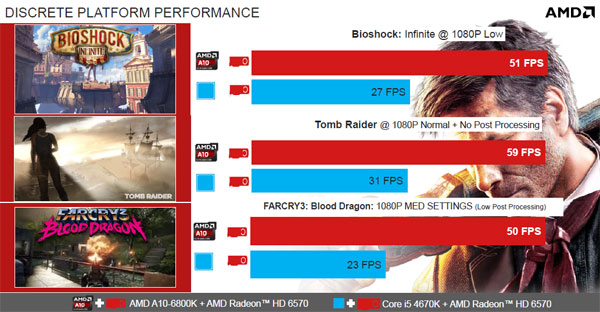AMD Dual Graphics Analysis: Better Benchmarks; Same Experience?
AMD's Dual Graphics technology gives APU owners the ability to add a discrete GPU to their platforms for better performance. We take a close look at the results, both in terms of frames-per-second and experiential smoothness, thanks to captured video.
AMD Dual Graphics: Hybrid CrossFire, Reloaded
Update (8/16/2013): In light of your requests in the feedback section, we added Catalyst 13.8 beta video results to page nine of this review.
What AMD now calls Dual Graphics was originally referred to as Hybrid CrossFire. From a technical standpoint, the older designation was probably more on-point, since the feature leverages AMD's multi-GPU technology as a means to scale the performance of an APU using discrete graphics.
Simply, that means you're able to take an APU-powered system and add a Radeon card, link them together, and harness the resources of both to push frame rates higher than you'd see from either the APU or add-in card on its own.
The Dual Graphics brand was introduced alongside AMD's Llano-based APUs in 2011, which I had the opportunity to review. While I acknowledged the appeal of Hybrid CrossFire, I experienced a few glitches with the original implementation. At the time, I hoped to revisit Dual Graphics once it matured. Over time, Llano gave way to Trinity, and Trinity was succeeded by Richland.
AMD had three generations to refine its hardware and software. So, we thought it high time to test Dual Graphics more thoroughly. After all, the company is making some pretty bold claims about the feature's potential gains. The slide below comes from the press deck that accompanied Richland's launch:
During the past two years, we've accumulated a handful of questions about Dual Graphics. For example, AMD recommends that you don't imbalance its APUs with anything more than a Radeon HD 6670. And yet, we've heard that the Radeon HD 7750 makes a good accompaniment in a Dual Graphics array. Is it even possible to mix a VLIW5-based APU and a GCN-based add-in card using this technology? If so, do cards faster than the Radeon HD 6670 yield worthwhile results for the extra money you're spending? Are there any Dual Graphics-related limitations you should know about? We're setting out to answer those unknowns.
I also wanted to incorporate our FCAT-based analysis, which measures the dropped and runt (too small to perceive) frames generated by a multi-GPU configuration using video capture. Unfortunately, we can’t get the tool to successfully process video generated by Dual Graphics, and AMD tells us that the issue we're encountering won't be fixed in the foreseeable future. If you remember back to AMD A10-6700 And A10-6800K Review: Richland Hits The Desktop, the problem was that bits of adjacent frames would show up where there weren't supposed to, like this:
Get Tom's Hardware's best news and in-depth reviews, straight to your inbox.
See the tear in the image? We aren’t satisfied with this state of affairs, so we found another way to objectively evaluate the effectiveness of Dual Graphics: using the actual video capture we'd normally feed through FCAT to generate data. You're going to be astonished by the dramatic results (at least, we certainly were). We'll talk more about that video demonstration on the next page.
Current page: AMD Dual Graphics: Hybrid CrossFire, Reloaded
Next Page Video Demos, Test System And Benchmark SetupDon Woligroski was a former senior hardware editor for Tom's Hardware. He has covered a wide range of PC hardware topics, including CPUs, GPUs, system building, and emerging technologies.
-
beta212 Hmm, IDK, I feel like there is definitely a performance boost in certain games that are just bordering on playability. That said, if you want really good graphics, why not buy the Athlon with disabled GPU cores? Same goes for the intel P series. Just add a discrete card.Reply -
17seconds "That's just not right."Reply
If I had just paid good money for a new graphics card for Dual Graphics, I'd be feeling pretty well cheated out of my money right now. -
joytech22 The drivers tested in this analysis are a tiny bit too old, just before the Crossfire Frame Pacing fix was released.Reply
Could we see this performed again with Catalyst 13.8?
-
cleeve Reply11356019 said:The drivers tested in this analysis are a tiny bit too old, just before the Crossfire Frame Pacing fix was released.
Could we see this performed again with Catalyst 13.8?
See page 2:
"You'll notice that we're using the Catalyst 13.6 Beta 2 driver instead of Catalyst 13.8 Beta, which adds a frame pacing feature for smoother, more consistent output. AMD tells us that the new driver does not affect Dual Graphics configurations. It only works with multiple discrete GPUs. Rest assured that the configuration we're presenting is as up to date as possible."
-
Calculatron Despite the bad news, I think this article was just what a lot of people needed. It helps clears up a lot of confusion and hearsay about AMD Dual Graphics options, like the being able to enable the Radeon HD 7750, or if GDDR5 makes any difference or not. More importantly, it shows how important software optimization is for product performance, and hopefully AMD strives to eliminate similar issues in the future.Reply
As this issue unfolds, I hope there are as informative follow-ups to accompany them. Good job! -
rpgplayer Well, now I see that my Llano box I built for a media center 2 years ago will be completely rebuilt rather than getting an add in card. If AMD's next gen APU will use the FM2+ boards as well I may go that route. If not, I'll probably wind up dumping AMD all together and go with an Intel rig.Reply -
If only AMD spent more of their time and their resources on software optimization rather than on those competition-bashing ads. Seeing some silly ads or reading about some flip/flopping (I now get paid by a different overlord) salesman, bashing Intel or nVidia products, does not instill the confidence in buying AMD products, specifically their APUs and (professional) GPUs. I really do want to buy your stuff AMD; less marketing more software development...pleeease.Reply


